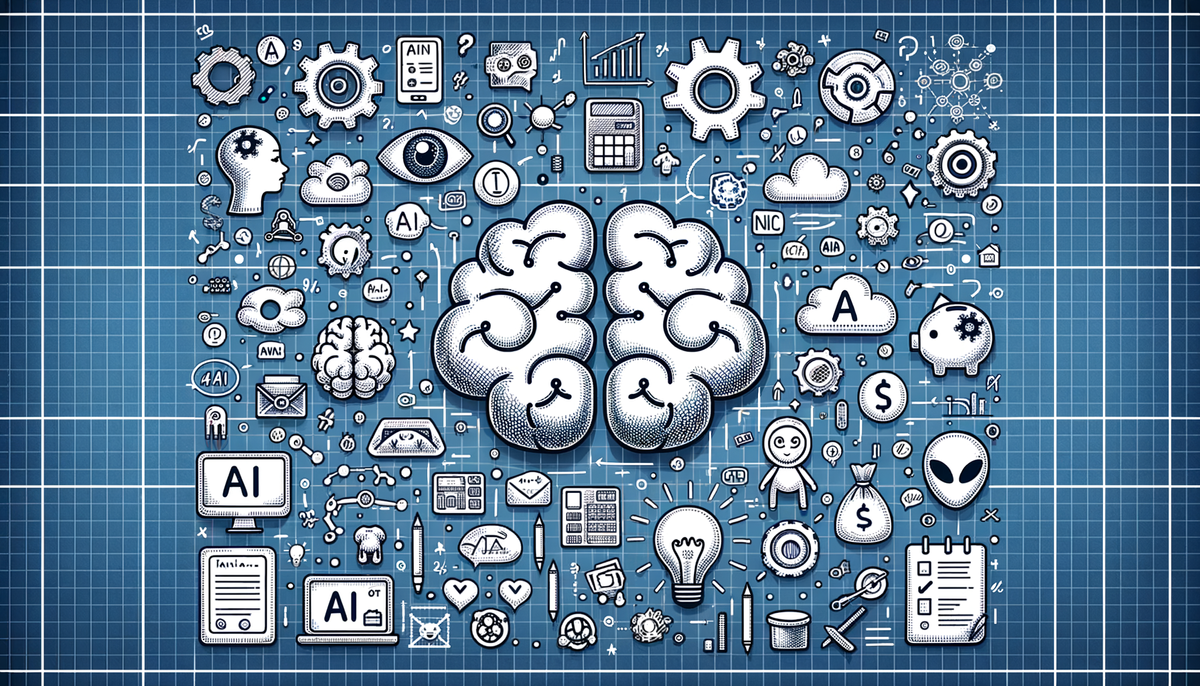How AI is Shaping Industries and Economies

AI's rapid evolution is casting ripples across industries—from the precision of accounting to the complex dynamics of investment bubbles—proving that innovation can simultaneously empower and unsettle the global business stage.
AI in Financial Services and Accounting
The unveiling of Digits’ new AI accounting tool, alongside the exciting announcement of welcoming a co-founder from Xero, is a testament to the transformative potential of artificial intelligence in finance. This move underscores how AI is already reshaping core financial functions. By automating routine cognitive tasks such as data entry, reconciliation, and compliance, such tools can allow financial teams to reallocate their focus towards more strategic decision-making.
Recent innovations in financial AI not only promise increased accuracy and efficiency, but also pave the way for entirely novel ways of approaching financial analysis. Transactions that once took hours for human teams to process can now be handled swiftly, letting businesses operate on a real-time basis. More importantly, as companies integrate AI into their accounting processes, they also benefit from enhanced analytical capabilities that allow them to predict trends and avoid potential financial pitfalls.
This breakthrough can be paralleled with broader industry evolutions detailed in articles like Game-Changing AI Solutions and The Future of Innovation on AI.Biz, where the convergence of technology and traditional business models is leading the charge towards smarter operations. Investors and companies alike are starting to realize that the digital transformation in finance is not just inevitable, but a cornerstone of future business resilience.
The Mirage of a Financial AI Bubble
Not all voices in the AI arena are filled with optimism. One compelling perspective comes from Tomlinson’s cautionary analysis, which warns of an impending burst in the financial AI bubble—a scenario that might have particularly tough repercussions for certain regions, such as Texas. According to this viewpoint, while the infusion of AI is hailed as the next big leap, it may also be inflating market valuations to unsustainable levels.
This sentiment is reminiscent of previous technological booms, when significant hype was followed by sudden market corrections. It serves as a reminder that while AI holds tremendous promise, the financial enthusiasm surrounding it could sometimes overshadow fundamental economic metrics. The progression of AI into mainstream applications does not immediately translate into long-term value if it is driven by speculative financial exuberance.
In this vein, investors are urged to exercise caution. The debate over the sustainability of the current AI investment push stands as a vital counterbalance to unbridled techno-optimism. While some see the financial sector's embrace of AI as a revolution, others voice skepticism regarding the risk of overvaluation. As one market observer famously put it,
“Mastering the technology to create effigies of ourselves, will be our downfall.” A.R. Merrydew, Inara
This perspective nudges us to remain grounded and evaluate measurable performance rather than relying solely on futuristic promises.
Trailblazing Startups: The Birth of AI Science Factories
A new flagship startup is stepping boldly into the limelight, aiming to set up what can only be described as “AI science factories”. This ambitious goal sees the company positioning itself at the nexus of research-driven innovation and pragmatic industrial application. By establishing dedicated facilities that harness AI to drive scientific research, they are not only building an infrastructure for breakthrough discoveries but are also creating scalable models for industries from materials science to biotechnology.
The concept of an AI science factory is a dramatic shift from traditional R&D setups. It leverages deep learning, automation, and massive data integrations to expedite the pace of discovery. Researchers are now able to simulate experiments and model outcomes at speeds and scales that would take years in conventional laboratory settings. Such integration points towards a future where the gap between theoretical research and commercial application is significantly narrowed.
This trend is in harmony with broader innovations covered on AI.Biz. For example, the discussion in AI Agents: The Future of Workforce Transformation illustrates how sophisticated AI solutions are now not only tools for automation but also catalysts for enhanced human work. The merging of automated research facilities with a redefined human workforce could signal the advent of an entirely new industrial era—one where AI is at the heart of both scientific discovery and day-to-day operations.
Investment Dilemmas: Navigating the AI Ecosystem
The investment landscape in AI is a double-edged sword. On one hand, the technology is revolutionizing business operations and opening up new revenue streams. On the other, the fluctuating market sentiments around companies like Manus AI, and the volatile relationship with giants such as NVIDIA, send a cautionary note to potential investors. The query “Should AI investors worry about Manus AI?” encapsulates a more extensive discussion around the risks associated with investing during times of rapid technological change.
Fundamentally, investors find themselves caught in a dynamic interplay of rapid innovation and market speculation. On one side, there is the zeal for cutting-edge technology that promises groundbreaking advancements. On the other, inherent market volatility—exemplified by the speculative fervor seen in various segments of the tech bubble—requires a balanced evaluation of risk versus reward.
The unfolding narrative suggests that an investor's decision-making process should now include an assessment of both technological viability and market integrity. Academic research has long noted that technology cycles can be both frenetic and unpredictable, a warning echoed in discussions surrounding modern tech stocks. Here, a careful approach to portfolio diversification and long-term investment horizons might serve investors better than chasing immediate gains.
For those looking to dive deeper into how AI is reshaping business models and investment standards, the article OpenAI's Vision for Business AI Agents on AI.Biz provides a comprehensive look into how personalized AI solutions are redefining operational cultures across industries.
Enterprise AI Solutions and the GPU-Free Revolution
Breaking away from conventional AI deployments, VCI Global’s dual announcements regarding their GPU-free enterprise AI solutions and their open-source DeepSeek LLM-based offerings marks a significant pivot in how enterprise AI is delivered. This innovative approach leverages the power of large language models without relying on traditional, resource-intensive GPUs. Instead, by streamlining deep learning processes, VCI Global promises more accessible and cost-effective AI solutions for businesses.
The movement towards GPU-free solutions is more than just a technical tweak—it represents a broader strategic repositioning in enterprise AI. Companies burdened by high operational costs can now evaluate AI implementations that are lighter on infrastructure yet potent in execution. Open-source initiatives, in particular, democratize advanced technologies, enabling startups and established enterprises alike to harness near state-of-the-art AI capabilities with fewer barriers.
Such innovation heralds a new era where scaling AI across various industries becomes not only feasible but is also financially sensible. This approach contrasts with older models that relied heavily on costly hardware. The advancement holds promising implications for industries where margins are tight but the demand for rapid data processing and decision-making is paramount.
By following this GPU-free route, more enterprises—ranging from e-commerce platforms to healthcare providers—can integrate robust AI systems while balancing cost and scalability. As discussed in The Trials and Triumphs of AI in the Modern World on AI.Biz, this kind of paradigm shift helps demystify AI for many businesses that have been skeptical of its traditional resource demands, paving the way for a broader adoption of AI-driven automation strategies.
AI Adoption in the Pharmaceutical Industry
While AI is making waves in finance, research, and enterprise IT, the pharmaceutical industry is also emerging as a significant player in the AI revolution. Pharmaceutical companies are increasingly investing in training programs designed to upskill their workforce in AI. This strategic move is aligned with the recognition that future competitiveness will depend on the effective integration of automation and data analytics in drug discovery and clinical trials.
Training employees on AI isn't merely about software proficiency; it involves instilling a mindset of data-driven decision-making across the board. The emphasis is on empowering scientists, researchers, and operational staff with the knowledge and tools necessary to harness AI innovations. As a result, pharmaceutical companies can tap into predictive analytics, streamline complex clinical studies, and accelerate the pace of innovation in drug development.
The adoption of AI in pharmaceuticals represents a confluence of technology and healthcare—a sector that has historically been resistant to rapid change but is now witnessing a transformative shift. Companies that invest in comprehensive AI training programs position themselves better for future challenges and opportunities, ensuring that they remain at the forefront of scientific advancements while also optimizing operational efficiencies.
This development can be seen as a microcosm of the broader trends in industry-specific AI adoption. While each sector faces its unique challenges, the underlying driver is the same: the future is data-intensive and capable of enormous leaps in efficiency and innovation when technology is harnessed correctly.
Insights and Reflections on the AI Revolution
Looking at the spectrum of AI applications—from accounting software and financial bubbles to startup laboratories, innovative enterprise solutions, and workforce training—the message is clear: artificial intelligence is no longer a futuristic concept, but a current and powerful force shaping business strategies globally.
In reflecting on these developments, I am reminded of the timeless interplay between innovation and caution. While it is tempting to embrace the glowing promises of AI, each breakthrough also invites careful scrutiny. Analyzing the successes of Digits in deploying an AI accounting tool alongside the risks highlighted by critics of the tech bubble, it is evident that a balanced perspective is essential. It’s about leveraging AI to create value while mitigating potential downsides associated with over-hype or misaligned technology investments.
There exists a duality here that is both challenging and inspirational. On one side, we see groundbreaking innovations being deployed in real-time, and on the other, alerts about market vulnerabilities that caution against unbridled enthusiasm. The history of technological revolutions is replete with similar patterns: great leaps forward often accompanied by moments of introspection.
For instance, the pioneering experiments in open-source deep learning frameworks, like those implemented in VCI Global's GPU-free solutions, illustrate how businesses are pushing boundaries while also redefining traditional computational paradigms. The quest for efficiency and scalability is prompting fresh thinking about infrastructure and deployment—a trend that might well reshape the entire business technology landscape in the coming years.
Making sense of these trends requires not only an understanding of the technology itself, but also an appreciation for its societal and economic implications. As we move into an era where digital transformation is a given, every sector from finance to life sciences must adapt and innovate. The convergence between AI research and practical industry applications is more than a technical marvel—it is a revolution in the way businesses operate, innovate, and plan for the future.
Further Readings
For readers interested in exploring these disruptive trends further, here are some of the pivotal analyses from AI.Biz:
- Game-Changing AI Solutions and The Future of Innovation – A look into how AI is fundamentally changing business innovation.
- AI Agents: The Future of Workforce Transformation – An exploration of the evolving role of AI agents in revolutionizing open talent and workforce dynamics.
- OpenAI's Vision for Business AI Agents – Insight into personalized AI strategies for businesses in the modern era.
- The Trials and Triumphs of AI in the Modern World – A comprehensive update on the intersections of technology and market realities.
Conclusion
The diversity of AI applications across industries vividly highlights one undeniable truth: the AI revolution is complex and multifaceted. Whether streamlining financial processes, fueling disruptive startups, challenging market valuations, or transforming workforce training in pharma, AI forces us to balance bold innovation with careful evaluation.
Its trajectory is both promising and cautionary—captivating the imagination of innovators while reminding us to remain vigilant about economic fundamentals. As we navigate this intricate landscape, we find ourselves at the confluence of rapid technological advance and market uncertainties, a juncture not unfamiliar in the annals of technological progress.
Embracing AI with an informed perspective will be the key to harnessing its full potential—building a future where efficiency, creativity, and sustainable growth coalesce harmoniously.





